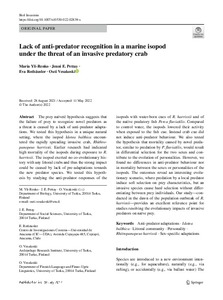Lack of anti-predator recognition in a marine isopod under the threat of an invasive predatory crab
Pettay Jenni E; Rothäusler Eva; Vesakoski Outi; Yli-Renko Maria
Lack of anti-predator recognition in a marine isopod under the threat of an invasive predatory crab
Pettay Jenni E
Rothäusler Eva
Vesakoski Outi
Yli-Renko Maria
SPRINGER
Julkaisun pysyvä osoite on:
https://urn.fi/URN:NBN:fi-fe2022091258647
https://urn.fi/URN:NBN:fi-fe2022091258647
Tiivistelmä
The prey naivete hypothesis suggests that the failure of prey to recognize novel predators as a threat is caused by a lack of anti-predator adaptations. We tested this hypothesis in a unique natural setting, where the isopod Idotea balthica encountered the rapidly spreading invasive crab, Rhithropanopeus harrissii. Earlier research had indicated high mortality of the isopods during exposure to R. harrissii. The isopod exerted no co-evolutionary history with any littoral crabs and thus the strong impact could be caused by lack of pre-adaptations towards the new predator species. We tested this hypothesis by studying the anti-predator responses of the isopods with water-born cues of R. harrissii and of the native predatory fish Perca fluviatilis. Compared to control water, the isopods lowered their activity when exposed to the fish cue. Instead crab cue did not induce anti-predator behaviour. We also tested the hypothesis that mortality caused by novel predator, similar to predation by P. fluviatilis, would result in differential selection for the two sexes and contribute to the evolution of personalities. However, we found no differences in anti-predator behaviour nor in mortality between the sexes or personalities of the isopods. The outcomes reveal an interesting evolutionary scenario, where predation by a local predator induce soft selection on prey characteristics, but an invasive species cause hard selection without differentiating between prey individuals. Our study-conducted in the dawn of the population outbreak of R. harrissii-provides an excellent reference point for studies resolving the evolutionary impacts of invasive predators on naive prey.
Kokoelmat
- Rinnakkaistallenteet [19250]
